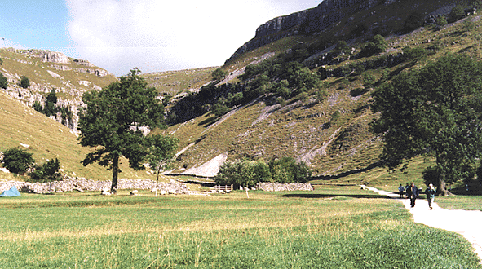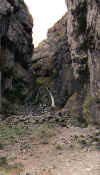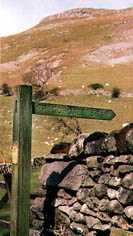
Gordale Scar

Gordale Scar
This is perhaps my favourite of all places in the Dales, Gordale Scar, (Malham).
This is where you need to go to recharge your batteries. One can only stand in awe at the
spectacular scene that greets you. The Scar itself is a huge gorge with near
vertical sides, over 100 metres (330ft) high. Gordale beck flows through a 'cave' at the
top of the scar and plummets down a chasm created by the Craven Fault. It is thought that
this huge gorge, with its caves and waterfalls was once an underground cavern whose roof
had long since collapsed, actually it was carved out by glacial meltwaters. Nearby is the
very pretty and magical, Janet's Foss, waterfall.
Famous people associated with this part of the dales include the great poet William
Wordsworth. He composed one of his lesser known sonnets at Malham Cove.
Both he and his sister Dorothy would visit Gordale Scar, they 'stayed several hours and
drank of its cool waters.' The Rev. Charles Kingsley encompassed much of
this local scenery in his famous book, 'The Water Babies', published in
1863. He also had this to say about Malham Cove: 'The awful cliff filling up the valley
with a sheer cross wall, and from beneath a black lip at the foot, the whole River Aire
coming up, clear as crystal, from unknown abysses.' A local man who found fame was Captain
James King. He accompanied Captain James Cook to the South Seas. Many artists
have painted the rugged scenery at Gordale Scar including Joseph Mallord William Turner.
When visiting the area, keep your eyes open for kestrels, buzzards, kingfishers, dippers
and owls. Flowers, such as lily of the valley, thrive here, the smell of wild garlic
(ramsons) is here, dogs mercury is also dominant. Camping is permitted at Gordale (you can
see my tent in the left of the picture). A walk into Malham in the evening can be rewarded
with a pint (or two!) of Theakston's Old Peculiar.
|
|
The Yorkshire Dales has thousands of miles of dry-stone walls, the only thing keeping these walls intact is the skill used in building them, no cement or mortar is used. These walls are some of the oldest man-made structures on earth still serving a purpose today. You see them everywhere - even up the side of mountains! I remember my cousin's amazement at seeing these walls for the first time when he visited England from his native New Zealand. |

